Hello all, my name is Amiyah Ogo and I attend school at Montezuma-Cortez High School and I am studying Marine Biology at the “REEF” at the University Of California Santa Barbara (UCSB). This week was my first week here at the REEF. I’ll explain what REEF stands for later in the blog. This week wasn’t very busy in terms of programs. Programs are groups of people who come to the REEF in order to learn about some of the different animals and ecosystems. Anyway this week I spent a lot of time just learning about the maintenance that goes into the REEF, the below paragraphs are detailed descriptions about what I did each day.
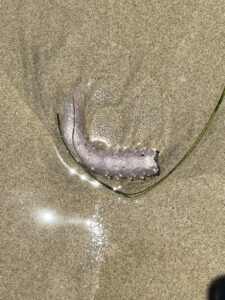
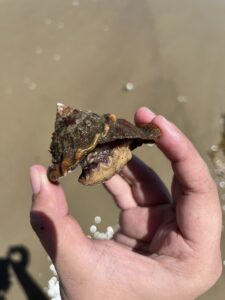
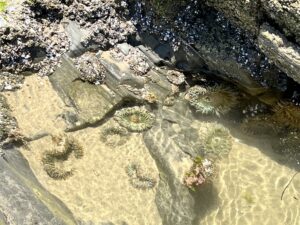 moved in on Saturday and didn’t start working until Monday, however due to the holiday Juneteenth the REEF was closed. So I got sent on a little scavenger hunt to Oil Point Reserve and Sandy Beach to learn about the different ecosystems in the area as well as look in the tide pools during low tide. In the tide pools I came across Sea Anemone’s, snails, and sea pickles! At first I thought the Sea Pickles were plastic because they were pink. After the tide pools I walked the beach until it was time to go back to my apartment. The photos above are from my beach walk, they consist of a tide pool I came across filled with Anemone, the sea pickle I mentioned earlier and a wavy turban snail I found.
moved in on Saturday and didn’t start working until Monday, however due to the holiday Juneteenth the REEF was closed. So I got sent on a little scavenger hunt to Oil Point Reserve and Sandy Beach to learn about the different ecosystems in the area as well as look in the tide pools during low tide. In the tide pools I came across Sea Anemone’s, snails, and sea pickles! At first I thought the Sea Pickles were plastic because they were pink. After the tide pools I walked the beach until it was time to go back to my apartment. The photos above are from my beach walk, they consist of a tide pool I came across filled with Anemone, the sea pickle I mentioned earlier and a wavy turban snail I found.
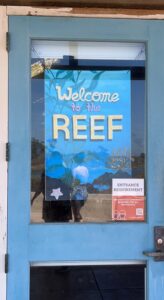 Tuesday was my first day at the REEF. The REEF stands for “Research Experience & Education Facility” and it is part of the Marine Science Institute’s Oceans-to-Classrooms education and outreach program. I started the day at a Zoom meeting, where I met the Content Coordinator intern. Today was also when we fed all of the different species of marine animals that are at the REEF. The foods we offer the animals are Mussels, Squid, Kelp, and Anchovy. After feeding and meeting all of the other staff at the REEF I went to lunch and finished the day reading “Island Visions” which is a book about a bunch of different events and discoveries that have happened in the Channel Islands. Today was also when I met my roommate and fellow intern Taylor Larose.
Tuesday was my first day at the REEF. The REEF stands for “Research Experience & Education Facility” and it is part of the Marine Science Institute’s Oceans-to-Classrooms education and outreach program. I started the day at a Zoom meeting, where I met the Content Coordinator intern. Today was also when we fed all of the different species of marine animals that are at the REEF. The foods we offer the animals are Mussels, Squid, Kelp, and Anchovy. After feeding and meeting all of the other staff at the REEF I went to lunch and finished the day reading “Island Visions” which is a book about a bunch of different events and discoveries that have happened in the Channel Islands. Today was also when I met my roommate and fellow intern Taylor Larose.
Wednesday was when we had our first program come into the REEF. The Family Vacation Center is a weeklong Family Vacation Camp and today was when kids K-3rd Grade came in to learn about the different species we have. Once the kids left we siphoned out the tanks. This is how we clean out all the shells and scraps that the animals didn’t eat the day before. Once I was done siphoning I then learned how to shuck mussels. This is how you get food out of the mussels for the fish, however today we shucked for the Lab. This is how they test different water properties in the ocean since Mussels are filter feeders. The photo shows one of the children who visited through the family vacation center learning about one of the sea stars
On Thursday I went to the REEF with two aquarists to learn about a current experiment going on called TUTH (Turning up the Heat). I basically learned about a semi open aquarium system works. as well as the electrical stuff that comes with a semi open tank system. Just for some clarification a semi open tank system is a type of cycle in an aquarium where water is both cycled through the aquariums, like a closed system, but also some water is released into the drain, like an open system. Some of the different equipment that the experiment was using was a flow switch, chiller, heater, pump, UV filter, and the temperature control. My favorite part was probably the circuit that occurs in order to keep the cooler tanks at the correct temperature. To put it into simple words the water goes through the main filter, where the temperature probe is. The temperature prop is hooked up to the temperature control device, which is linked to the chiller and flow switch. A cool thing about how the flow switch and chiller work is that the chiller is only on when the flow switch is going. This only happens when the temperature of the water is higher than the set temperature on the device. The flow switch has to be on at the same time as the chiller because if the flow switch isn’t on, and the chiller is, then the chiller will actually freeze and the entire system will break. That may seem a little complicated, I found it complicated at first as well. After this we did some food prep, which is when we prep all of the food to feed the animals the next day. We also do this thing called “carding” which basically is just taking a card and gently scraping off all the algae that has grown in the tanks. Luckily we finished in time before the UCSB incoming freshman came to tour the REEF during the UCSB orientation. Once the orientation was finished we did some last minute tidying up and then I walked back to the apartment I’m staying at, made some rice balls, and enjoyed the rest of my night reading more of the book “Island VIsions”.
On Friday I started my day reading Island Visions and then got to work. Today was when we fed all of the different marine species in The REEF. My favorite animal to feed was our Red Abalone. We feed these guys kelp! Each Abalone at the REEF gets two pieces. They were my favorite to feed because when you put a piece of kelp by them, their “foot” which is their strong muscle that helps them travel, will actually grab the kelp in order to eat it. After we were done feeding all of the different animals, two of the interns toured me around UCSB and then we walked back to my apartment together before going our separate ways.
On Saturday we had to siphon all of the tanks. In case you haven’t picked up on how the schedule works, we siphon the day after we feed. This is to help keep the tanks all nice and clean for when we have programs and open doors. This was all I had to do today at the REEF so after that me and two other aquarists biked home together.
This week at the REEF I learned a lot about the more maintenance side of the REEF. Having the programs come in definitely helped bring me up to speed on facts about some of the animals that live in the REEF. Some of the things I learned was that the Echinoderms, the phylum that sea stars, sea urchins, and sea cucumbers are in, don’t actually have blood. Echinoderms fill themselves up with water and if you pick them up sometimes they will push out some of that water. Another thing I learned is that the Moray eel, the same kind of eel I had fed my first day at the REEF, has two sets of jaws. One of my favorite facts I learned is that sea stars, in order to eat, will pry open mussels with their tube feet and then push out their stomach in order to eat the meat inside. This just means that sea stars digest their food immediately after eating. In my free time I’ve been exploring the Isla Vista and Santa Barbara area. I’ve also been doing alot of cooking, my favorite thing I’ve made would have to be the chicken tender recipe that I wildly came up with and actually ended up tasting amazing.

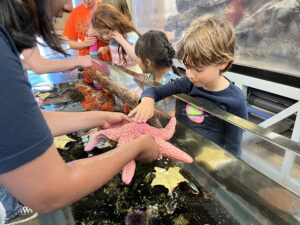
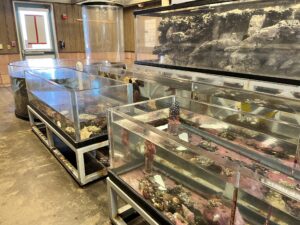
Sounds fascinating! What an amazing opportunity, you are so lucky! I cant wait to read more about your experiences 😊
So cool! Great job on documenting your experiences!
Wow!
I love your blog, as I learned alot about the ocean